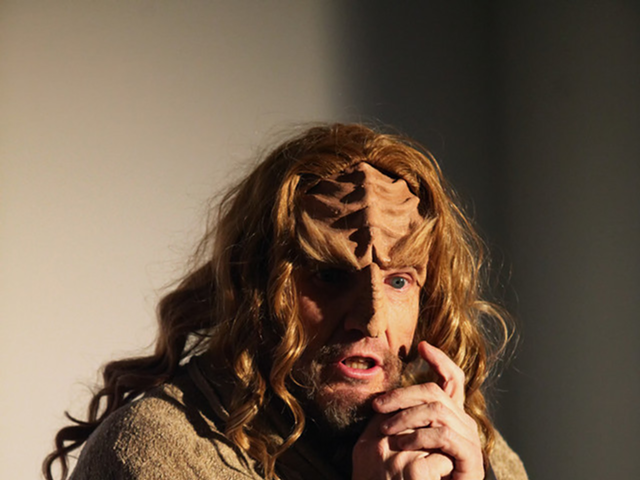“It’s gotta be the shoes,” Nike’s 1980s Air Jordan ads marveled. And if you ask Cincinnati Art Museum curators Cynthia Amnéus and Amy Dehan which of today’s fashions stand the test of time, they too point to shoes — at least those in What’s New: Fashion & Contemporary Craft.
The “Fang Shoes” by Dutch designer Iris Van Herpen are fierce. Each sole features 10 shiny black teeth molded out of fiberglass and carbon fiber. A single fang suggests the sexiness of a spike heel, but a full set appears to provide the stability of a hiking shoe. It’s the guys who’ll be wobbling when they see these lace-up booties that are the color of dried blood. The fuzziness of the pony fur upper is the only hint of vulnerability.
Such innovation and experimentation are at the heart of this exhibit, which showcases more than 20 recent additions to the museum’s fashion and craft collections. All the items were made since 1950.
With an eye toward color, texture and concept, Amnéus and Dehan have matched clothes and purses with bowls and vases. This is an accessible show, thanks to the pairings, the small size and the fact we all can relate to crafts and fashion, even the avant-garde.
Van Herpen’s shoes are shown between “Weapon of Choice,” a skull-shaped porcelain gas pump by Virginia artist Michelle Erickson, and “Keep Sake,” a bowl with pointy leaves that resemble the tough outer layers of an artichoke. Woodturner Ron Fleming used buckeye burl — a twisted, knotty, bark-covered tree growth — to craft the bowl.
All three works have edginess and an intimidation factor, says Dehan, the museum’s curator of decorative arts and design. “The artists are testing comfort levels. Erickson’s sculpture is so cutting-edge and politically charged.”
The pump, decorated with a blue dragon design, rests on an earthenware brick imprinted with fossils. The Chinese pattern resembles pottery that might be found during a dig at one of Virginia’s colonial sites, and the brick looks as if it might come from a wall at Williamsburg.
“Erickson is using traditional materials, but not in a functional way,” Dehan says. “She is making a statement on current events.”
The other shoes in the exhibit come from Zaha Hadid, the architect of Cincinnati’s Contemporary Arts Center, and were commissioned by Lacoste.
Hadid’s purple leather boot features a textured pattern inspired by the company’s crocodile logo. A strap supported by spring steel snakes up from the slipper base and wraps around a woman’s calf.
“It very much relates to her architectural work,” says Amnéus, the museum’s curator of fashion arts and textiles. “Her buildings tie into the landscape and are undulating.”
The boot also very much relates to Virginia Dotson’s spiraling vase beside it. Not just appearance but innovation — the willingness to challenge materials — links Hadid’s design to Dotson’s. Dehan notes that Dotson glued many thin layers of wood together to mimic a rocky Arizona landscape.
Complete mannequins are missing in this exhibit, allowing for a better comparison of clothes and fine crafts. Amnéus likes to present fashions as sculptural pieces. “For me,” she says, “a dress is really sculpture on a body.”
That’s also the view of Japanese fashion designers Yoshiki Hishinuma, Issey Miyake and Rei Kawakubo. “Rei is not interested in making you look pretty,” Amnéus says as she stands before the woman’s tortured-looking “Twist Jacket.” “These (clothes) are obviously pieces of artwork, just to make a statement.”
Amnéus particularly admires Hishinuma’s experimentation with textiles. The folded-down panels of his “Laminated Dress,” made of urethane and polyester, look like sheets of copper. With sheer material exposed, the dress itself looks like Rude Osolnik’s hole-riddled “Natural Edge” bowl next to it. The late Kentuckian revived woodturning as an art and pioneered the use of flawed pieces such as burls and roots.
What makes What’s New new is that the designers and crafters have not followed traditional paths. “Their own treatments, the techniques they developed, have put them on the map,” Dehan says.
Amnéus expects to continue to see a surge of technology in fashion and decorative arts, even as creators reach back to their roots by using ecologically sound materials or historical influences. Dehan thinks more crafters will move toward statement pieces and away from the functional.
These designers and artists were chosen because they are catalysts for recent change, the curators say. “And that’s why we hope they stand the test of time,” Amnéus concludes.
WHAT’S NEW: FASHION & CONTEMPORARY CRAFT continues through Jan. 19 at the Cincinnati Art Museum. More: cincinnatiartmuseum.org.






